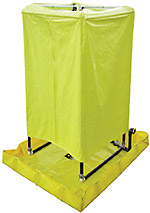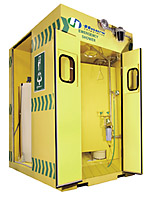
That’s great… many plants across the country do the same thing. It shows management’s focus on safety and reminds workers of their responsibility to safety every time they drive through the gates. But do statistics and bar charts de-humanize the idea of emergency response?
The first step in attending to the personal needs of accident victims is recognizing those needs. Accident victims have suffered a trauma, which brings the possibility of pain, nervous agitation and accompanying shock, along with possible embarrassment.
Selection of the proper equipment, reasonable placement of equipment and training will go a long way toward mitigating victim concerns. Proper procedures provide immediate first-aid assistance and reassure and comfort the victim. Training on the risks and dangers present, as well as the emergency response equipment available — including locations and use instructions — is an obvious necessity.

Equipment needs
Let’s consider specific equipment needs. The requirement for quality emergency showers and eyewashes is fundamental to a quality response. Emergency equipment that doesn’t operate properly, hasn’t been adequately maintained or does not provide the required capabilities will exacerbate the victim’s anxiety.High-quality emergency equipment, in the proper numbers and locations should be assumed. This is not a place to skimp. Features like high-visibility signage, easy-to-operate actuation, flow controls to assure smooth operation and diffused spray eyewash and shower heads are good investments. Remember, the products that you choose can have an impact on the degree of anxiety experienced by accident victims.
Imagine an injured employee needing to disrobe under an emergency shower flow and stand there for the required 15-minute use cycle. Consider that the victim is probably embarrassed that the accident even occurred. Add in the embarrassment of an exposed 15-minute shower and you get some sense of their state of mind.
A number of products on the market address the privacy needs of victims using emergency equipment. Figures 1 and 2 show drench showers (both portable and plumbed in) with privacy curtain attachments.
Many specifiers are moving toward high-end visibility and privacy by specifying Enclosed Emergency Environment (E3) products. An example of these products is shown in Figure 3 below. These emergency shower and eyewash booths offer superior visibility to accident victims, as well as privacy during use. In larger sizes, they also can provide space inside for safety personnel to assist the victim during use.

No torture tests, please
It’s imperative that your emergency response program encourages full cycle use. ANSI Z358.1-2004 stipulates that emergency showers and eyewashes should be used for a full 15-minute drench or irrigation cycle in all instances. Adhering to the required timeframe assures that all hazardous materials have been adequately flushed from the body, mitigating any potential further injury.In many geographic areas, municipally supplied water can become cold enough to make a 15-minute use cycle a torture test. Likewise, there are areas and hot ambient temperature industrial processes that can heat municipal water to dangerously warm levels, again possibly resulting in a shortened use cycle. It’s imperative emergency response assets reconcile these situations with either tempering or reverse tempering to assure that the water used is within a safe and comfortable range. Per the ANSI Z358.1 standard, the range should be between 60°F and up to below 100°F for both emergency showers and eyewashes.
Next, consider your emergency response maintenance and use procedures: ANSI requires that all emergency showers and eyewashes should be physically tested every week and thoroughly inspected every year. This not only assures proper operation, but it also flushes out debris in the system.
It’s also important that your operating procedures include the specific responsibilities of everyone involved in emergency response, including employees who could be potential victims. Written procedures assure that everyone knows his or her role and also provides valuable documentation in the event of a serious accident.
Finally, there’s proper training to consider. Training employees and management regarding the locations of your emergency equipment and how to operate the various response assets completes your overall preparation and response plan.
In sum, provide proper equipment in the right locations and have people well-trained and capable of operating with confidence and compassion in an emergency to assure that you are prepared for almost any emergency.